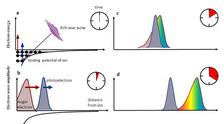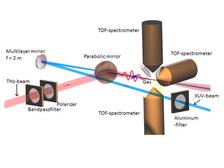Figure 1: An XUV photon liberates two electrons from an atom (a). The two electron wave packets run away from the ionic core (b). The later Auger electron reaches the earlier but slower photoelectron (c). Interaction of electrons leads to a time dependent energy exchange between the electrons.
A team of physicists in Germany led by Markus Drescher (Hamburg University) and Michael Bonitz (Kiel University) and scientists from DESY has, for the first time, observed a special race of two electron waves in an experiment at the free-electron-laser FLASH.
When a photon of sufficiently high energy hits an atom it may kick out an electron. Quantum mechanics predicts that the electron behaves like a wave that runs away from the atom. If the photon energy was chosen right then a second electron (Auger electron) may be liberated from the atom, racing behind the first one. The research team was able to detect how this second electron overtakes the first one within only a few femtoseconds (1fs = 10-15 seconds) and observe the dynamic exchange of energy between the two electrons when they are passing each other (see Fig. 1).
The key was the use of an ultrafast terahertz streak camera [1,2] where the FLASH XUV pulses are superimposed with far infrared (terahertz (THz)) light pulses from the FLASH THz undulator [3] (Fig. 2). The oscillating electric field of the THz pulses accelerates the electrons whereby the resulting momentum change depends on the ionization time and observation direction. Thus the time dependent energy exchange between the electrons can be reconstructed by measuring electron spectra for different THz field phases and field directions.
The experimental findings that were fully confirmed by theory and computer simulations have important consequences for future measurements of ultrafast processes occurring in atoms, molecules and solids as well as for pulse duration measurements at free electron lasers. The mutual interaction of electrons plays a key role in the matter around us, and the present work demonstrates that the electrons´ relative timing can be decisive.
References
[1] U. Frühling et al., Nature Photon. 3, 523-528 (2009).
[2] B. Schütte et al. ‚Opt. Express 19, 18833 (2011).
[3] M. Gensch et al., Infrared Phys. Techn. 51, 423-425 (2008).
Authors
Bernd Schütte, Sebastian Bauch, Ulrike Frühling, Marek Wieland, Michael Gensch, Elke Plönjes, Thomas Gaumnitz, Armin Azima, Michael Bonitz and Markus Drescher
| Further Information |
|







